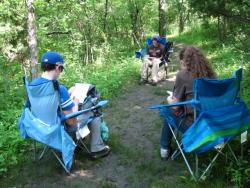K-State researcher leads summer camp for Olathe high school students
June 22, 2010

Woods is deeply interested in how people understand science. She thinks that to many students, science research is a bit of a black box - something that people who know a lot can do but which is a bit of a mystery to everyone else.
Woods sees it differently.
"Research is fundamentally curiosity-driven and evidence-based," Woods said. "Anybody who has questions and can observe or do tests or collect data in some other way that is based on actual evidence to answer their questions is a researcher."
One of the main goals of the camp was to afford students an immersion experience in research. Woods also wanted students to conduct a research project that was fairly low-expense and got them outside.
"All during the year they are indoors," Woods said. "They have access to the labs. This was an opportunity for them to be in the field."
Woods set up a project for the students to observe insect behavior and understand the relationships many insects have with plants as pollinators.
Nine students from Olathe North's Animal Health 21st Century Program participated in the field research camp. It was three hours a day, four days a week at Ernie Miller Park.
Within the framework of a pollinator observation project, students developed their own questions. Some worked in groups while others worked individually, and each chose a plant species to observe. One of their questions was to compare which species had the most insect pollinators, but then they also went further and asked if pollinators would come to the same species more often in the sun or in the shade, and so they collected additional data and conducted that analysis as well.
Woods said the students worked hard rain or shine with no complaints.
"It's not that they weren't uncomfortable," Woods said. "They certainly were. They would come into the shade for a little bit, but they would get right back out there. They were driven by their curiosity."
The students impressed Woods by how carefully they observed. They could see the competition between different insects, and that is studied by very high-level researchers, Woods said.
"They also said at the end that they had no idea how much plants and the environment and animals were all interrelated," Woods said. "They learned a lot in that sense."
- By Ashley Dunkak -